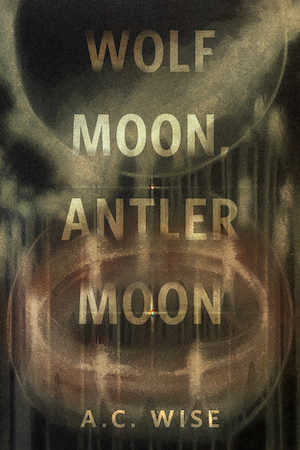In my favorite scene in Jonathan Glazer’s new thriller/satire/science fiction film—Under the Skin—Scarlett Johansson’s unnamed protagonist (she had a name in the novel!) tries to eat a piece of chocolate cake in a crappy restaurant and nearly chokes. Every head in the place turns to look at her like she’s a crazy person, but in fact, she’s just an alien and can’t eat cake, or really anything. This, I’m guessing is the split on how most viewers will regard the relative quality of this movie: you’re either the “regular” people staring in disbelief, or you’re the alien wondering what the hell is wrong with everyone.
Like the Michael Faber novel of the same name, Under the Skin presents an alien in the guise of a woman, driving around Scotland on the hunt for men. According to numerous interviews with Glazer, some of the initial scenes in which ScarJo picks up on men in clubs and on the road were unscripted, and the men were just random guys in the real world. If the murderer-as-protagonist premise weren’t already unsettling, the “realness” of the various victims amps the film’s creep factor all the way up. The plot and production of the movie then, is also its thematic premise: Under the Skin is about flipping the male gaze, which it achieves in every single way. In the book, Isserley was looking for meatier human males as per her instructions, but here, any bloke will do. This works for a lot of reasons, the most surprising of which that it’s actually bizarre to be living the year 2014 and witnessing ScarJo on screen with a man who isn’t also a famous person. The mere act of having ScarJo “slumming it” is part of what convinces you of the movie’s strong moral fiber.
However, for a science fiction fan curious about the aims of the alien, or even their methodology, Under the Skin isn’t so much as confusing, but vague to the point of truly testing the audience’s ability to care about anything. The dialogue is so sparse, and none of the talking is expository in any way. In various scenes, we begin to infer that ScarJo has some partners in crime in the guise of dudes on motorcycles. These guys, it seems, are responsible for disposing of any evidence that ScarJo has been anywhere. This is confusing for a lot of reasons, the biggest of which that we’re not actually sure of the actual apparatus used by ScarJo/Isserley to kill/capture these men. Once she brings them “back to her place” we suddenly see her walking across a long black room, with the men following behind her. They then sink into black goop, while ScarJo walks away unscathed. Where is this black room? Is it in ScarJo’s creepy van? If so, and if her van is bigger on the inside, can we call it murder and relative dimension in van? Actually, I guess the room with the black goop isn’t in her van at all, because at one point we see her taking a guy into a weird little apartment before the regular murder scene takes place. I imagine an argument someone would make against me here is that the big room with the black goop isn’t a “real place” but more of a metaphor for how Isserley kills this guys, and that our human brains couldn’t comprehend it. But, since it’s a movie for humans, with lots of driving around and other logistics, my human brain needs a little help.
Similarly, in an early scene, we see an alive ScarJo undressing a dead ScarJo, who apparently was a real person before the alien assumed her identity. It’s a creepy scene and it does a good job establishing the non-sexualized, but rather, more matter-of-fact nature of Under the Skin’s nudity, which is essential and one of the strengths of the movie. (Plus, I’ve been feeling cheated out of a ScarJo versus ScarJo doppelganger scene since 2005’s clone-flick, The Island.) However, in like the very next scene, alien ScarJo buys brand new clothes, begging the question as to why she had to wear the dead girl’s clothes to begin with. I suppose she couldn’t have shopped naked, but isn’t that what the Terminator did when he initially showed up? To be sure, it would have been derivative to have ScarJo act like the Terminator and walk around naked freaking everyone out, and this isn’t that kind of movie, but still. She couldn’t just send the motorcycle guy to get her some new duds? Do the various metaphors about “shedding skin” and “peeling back layers” need to be this ham-handed?
Discussing whether or not Under the Skin was a good movie then, becomes a little tricky. People who don’t love sci-fi often say 2001 is the best science fiction movie ever made, while many of us groan because we suspect people love it not because of the sci-fi, but because of the arty “otherness.” Because Under the Skin was a film was made in an arty way (unscripted scenes) and because it carries strong social commentary (flipping of the male gaze) it feels a thinking person with progressive and feminist values (like me!) is required to say this movie is good. To put it another way: every time ScarJo lures someone into the black goop, murder violins play at frenetic screeches to let you know that something BAD is going down. And really, stuff like that not only makes for bad science fiction, but is also just kind of annoying.
So, though a fine meditation on our screwed up male-centric culture, Under the Skin left me without much to really think about other than the allegory and the artistic cinematic trick, making the movie feel like it was written and directed by someone who once made music videos, which, you know, it was. Is this a science fiction movie for people who don’t think they like science fiction movies? Yes, but it might have worked just as well if ScarJo hadn’t been an alien, and instead just a murderer.
Ryan Britt is a longtime contributor to Tor.com and the creator of the Genre in the Mainstream column.










